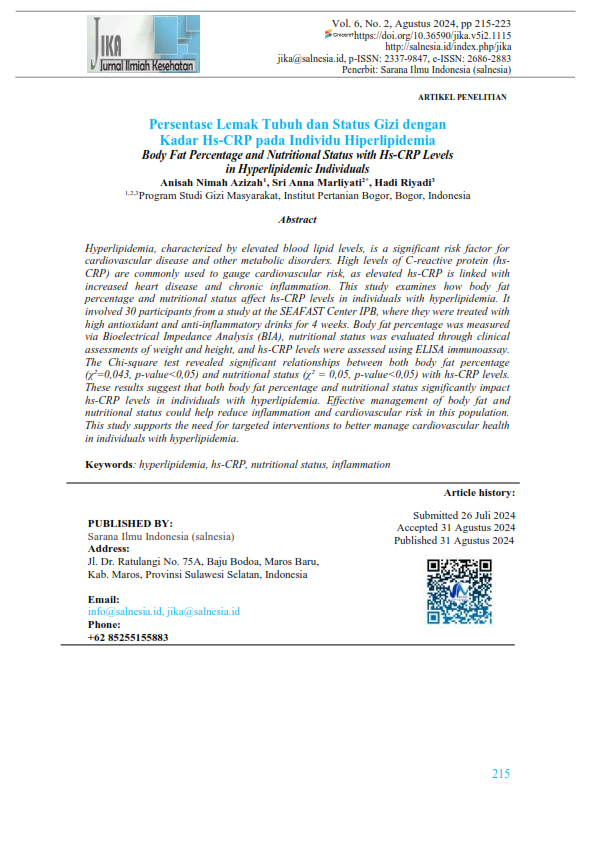Body Fat Percentage and Nutritional Status with Hs-CRP Levels in Hyperlipidemic Individuals
DOI:
https://doi.org/10.36590/jika.v6i2.1115Keywords:
hyperlipidemia, hs-CRP, nutritional status, inflammationAbstract
cardiovascular disease and other metabolic disorders. High levels of C-reactive protein (hs-CRP) are commonly used to gauge cardiovascular risk, as elevated hs-CRP is linked with increased heart disease and chronic inflammation. This study examines how body fat percentage and nutritional status affect hs-CRP levels in individuals with hyperlipidemia. It involved 30 participants from a study at the SEAFAST Center IPB, where they were treated with high antioxidant and anti-inflammatory drinks for 4 weeks. Body fat percentage was measured via Bioelectrical Impedance Analysis (BIA), nutritional status was evaluated through clinical assessments of weight and height, and hs-CRP levels were assessed using ELISA immunoassay. The Chi-square test revealed significant relationships between both body fat percentage (X²=0,043, p-value<0,05) and nutritional status (X² = 0,05, p-value<0,05) with hs-CRP levels. These results suggest that both body fat percentage and nutritional status significantly impact hs-CRP levels in individuals with hyperlipidemia. Effective management of body fat and nutritional status could help reduce inflammation and cardiovascular risk in this population. This study supports the need for targeted interventions to better manage cardiovascular health in individuals with hyperlipidemia.
Downloads
References
Bello OA, Ayanda OI, Aworunse OS, Olukanmi BI, Saladoye MO, Esan EB, Obembe OD. 2018. Solanecio biafrae: An Underutilized Nutraceutically-Important African Indigenous Vegetable. Pharmacognosy Reviews, 12(23): 128-132. https://core.ac.uk/download/pdf/158573517.pdf
Bertoluci MC, Rocha VZ. 2017. Cardiovascular Risk Assessment in Patients with Diabetes. Diabetology and Metabolic Syndrome. BioMed Central, 9(25): 1-13. https://doi.org/10.1186/s13098-017-0225-1
Gao Y, Wang M, Wang R, Jiang J, Hu Y, Wang W, Wang Y, Li H. 2024. The Predictive Value of the hs-CRP/HDL-C Ratio, an Inflammation-Lipid Composite Marker, for Cardiovascular Disease in Middle-Aged and Elderly People: Evidence from a Large National Cohort Study. Lipids in Health and Disease, 23(66): 1-11. https://doi.org/10.1186/s12944-024-02055-7
Hernández-Lepe MA, Wall-Medrano A, López-Díaz JA, Juárez-Oropeza MA, Luqueño-Bocardo OI, Hernández-Torres RP, Ramos-Jiménez A. 2019. Hypolipidemic Effect of Arthrospira (Spirulina) Maxima Supplementation and a Systematic Physical Exercise Program in Overweight and Obese Men: A Double-Blind, Randomized, and Crossover Controlled Trial. Marine Drugs, 17(5): 1-13. https://doi.org/10.3390/md17050270
Hu P, Dharmayat KI, Stevens CAT, Sharabiani MTA, Jones RS, Watts GF, Genest J, Ray KK, Vallejo-Vaz AJ. 2020. Prevalence of Familial Hypercholesterolemia among the General Population and Patients with Atherosclerotic Cardiovascular Disease: A Systematic Review and Meta-Analysis. Circulation, 141(22): 1742-1759. https://doi.org/10.1161/CIRCULATIONAHA.119.044795
Kandelouei T, Abbasifard M, Imani D, Aslani S, Razi B, Fasihi M, Shafiekhani S, Mohammadi K, Jamialahmadi T, Reiner Ž, Sahebkar A. 2022. Effect of Statins on Serum level of hs-CRP and CRP in Patients with Cardiovascular Diseases: A Systematic Review and Meta-Analysis of Randomized Controlled Trials. Mediators of Inflammation, 2022(1): 1-20. https://doi.org/10.1155/2022/8732360
Koutelidakis A, Dimou C. 2017. The Effects of Functional Food and Bioactive Compounds on Biomarkers of Cardiovascular Diseases. Functional Food Center, 1: 89-117.
Li X, Ren Y, Chang K, Wu W, Griffiths HR, Lu S, Gao D. 2023. Adipose Tissue Macrophages as potential Targets for Obesity and Metabolic Diseases. Frontiers in Immunology, 14: 1-16. https://doi.org/10.3389/fimmu.2023.1153915
Lin CF, Chang YH, Chien SC, Lin YH, Yeh HY. 2018. Epidemiology of Dyslipidemia in the Asia Pacific Region. International Journal of Gerontology, 12(1): 2-6. https://doi.org/10.1016/j.ijge.2018.02.010
Liu J, Li J, Xia C, He W, Li X, Shen S, Zhou X, Tong N, Peng L. 2024. The Effect of Hyperlipidemia and Body Fat Distribution on Subclinical Left Ventricular Function in Obesity: a Cardiovascular Magnetic Resonance Study. Cardiovascular Diabetology, 23(120): 1-13. https://doi.org/10.1186/s12933-024-02208-z
Miranda VPN, Dos Santos Amorim PR, Bastos RR, Canabrava KLR, Júnior MVM, Faria FR, Do Carmo Castro Franceschini S, Do Carmo Gouveia Peluzio M, Priore SE. 2020. Association of Lifestyle and Body Composition on Risk Factors of Cardiometabolic Diseases and Biomarkers in Female Adolescents. Mediators of Inflammation, 2020: 1-12. https://doi.org/10.1155/2020/9170640
Munasir Z. 2016. Respons Imun terhadap Infeksi Bakteri. Sari Pediatri, 2(4): 193-197. https://doi.org/10.14238/sp2.4.2001.193-7
Myint PK, Kwok CS, Luben RN, Wareham NJ, Khaw KT. 2014. Body Fat Percentage, Body Mass Index and Waist-to-Hip Ratio as Predictors of Mortality and Cardiovascular Disease. Heart, 100(20): 1613-1619. https://doi.org/10.1136/heartjnl-2014-305816
Ridker PM, Lei L, Louie MJ, Haddad T, Nicholls SJ, Lincoff AM, Libby P, Nissen SE. 2024. Inflammation and Cholesterol as Predictors of Cardiovascular Events among 13 970 Contemporary High-Risk Patients with Statin Intolerance. Circulation, 149(1): 28-35. https://doi.org/10.1161/CIRCULATIONAHA.123.066213
Roth GA, Mensah GA, Johnson CO, Addolorato G, Ammirati E, Baddour LM, Barengo NC, Beaton A, Benjamin EJ. 2020. Global Burden of Cardiovascular Diseases and Risk Factors, 1990-2019: Update From the GBD 2019 Study. Journal of the American College of Cardiology, 76(25): 2982-3021. https://doi.org/10.1016/j.jacc.2020.11.010
Saltiel AR, Olefsky JM. 2017. Inflammatory Mechanisms Linking Obesity and Metabolic Disease. Journal of Clinical Investigation, 127(1): 1-4. https://doi.org/10.1172/JCI92035
Szukiewicz D. 2023. Molecular Mechanisms for the Vicious Cycle between Insulin Resistance and the Inflammatory Response in Obesity. International Journal of Molecular Sciences, 24(12): 1-33. https://doi.org/10.3390/ijms24129818
Verma V, Sharma PK, Singh SP, Sarmah D, Patel R, Verma P, Tripathi SS, Arya D, Verma MK. 2024. Linking IL-6 and hs-CRP among Indian Patients with Myocardial Infarction. Bioinformation, 20(4): 378-385. https://doi.org/10.6026/973206300200378

Downloads
Published
How to Cite
Issue
Section
License
Copyright (c) 2024 Anisah Nimah Azizah, Sri Anna Marliyati, Hadi Riyadi

This work is licensed under a Creative Commons Attribution 4.0 International License.








